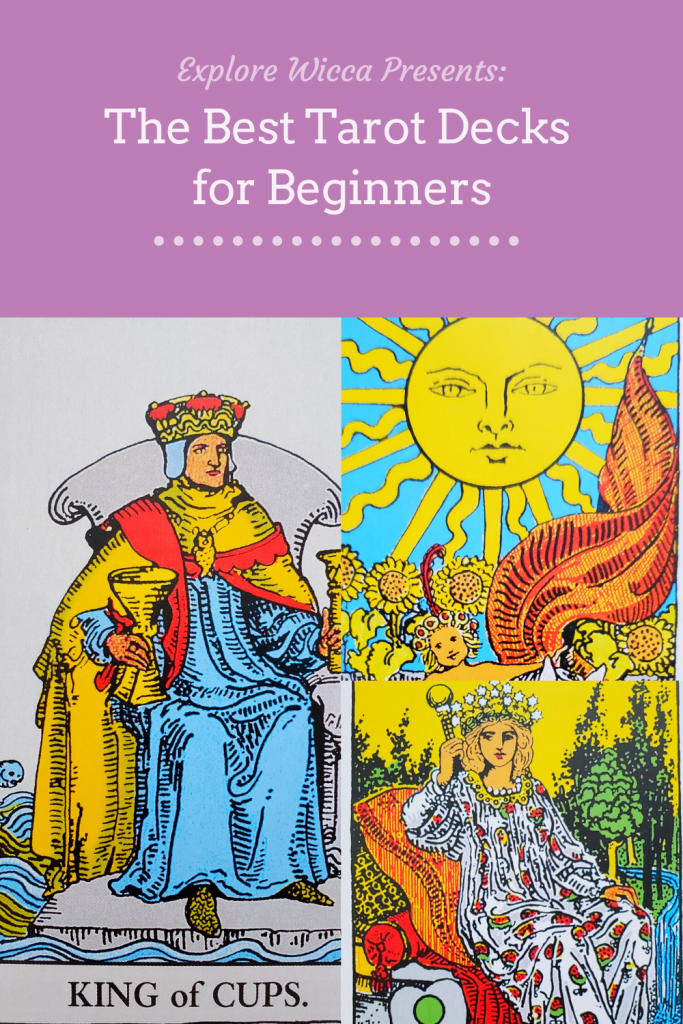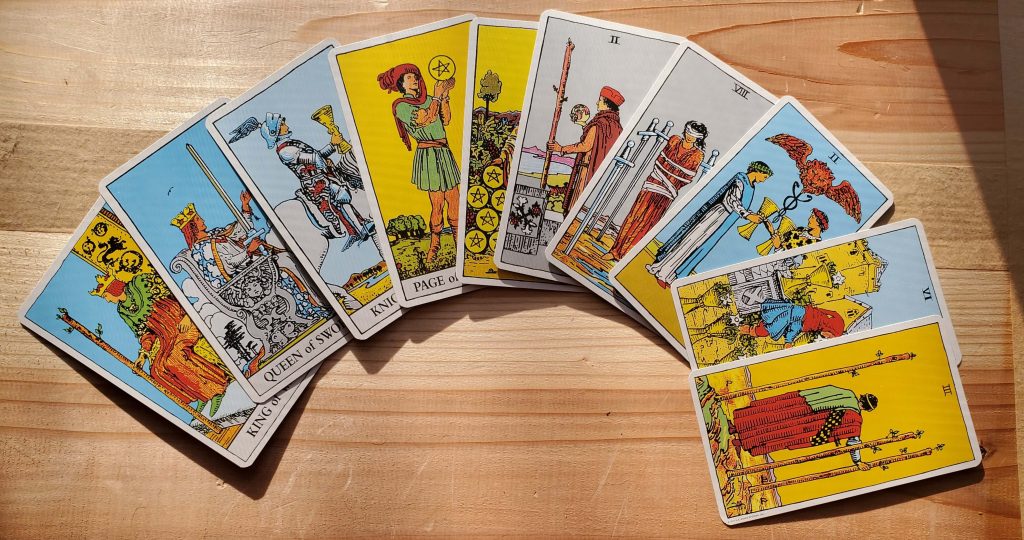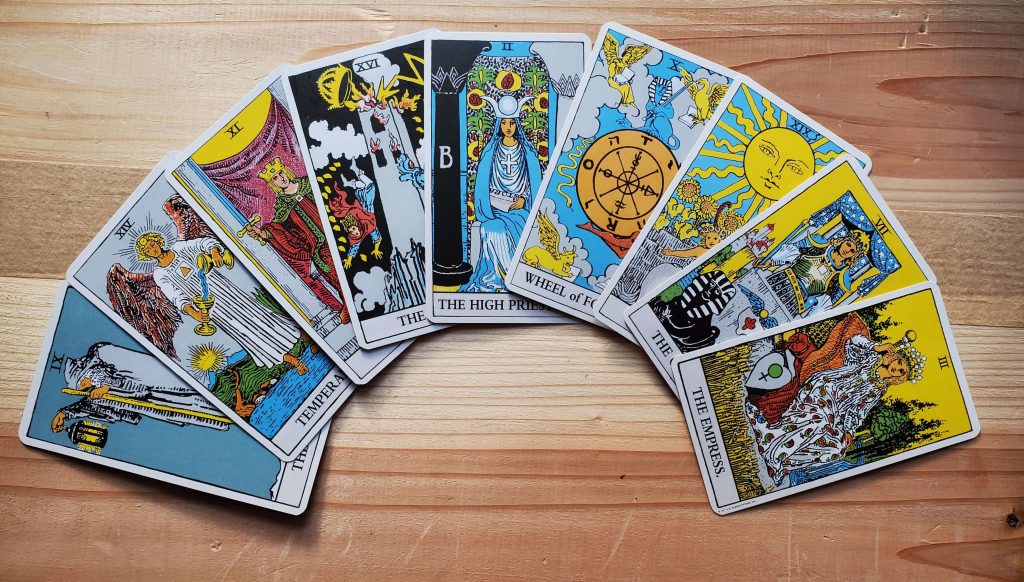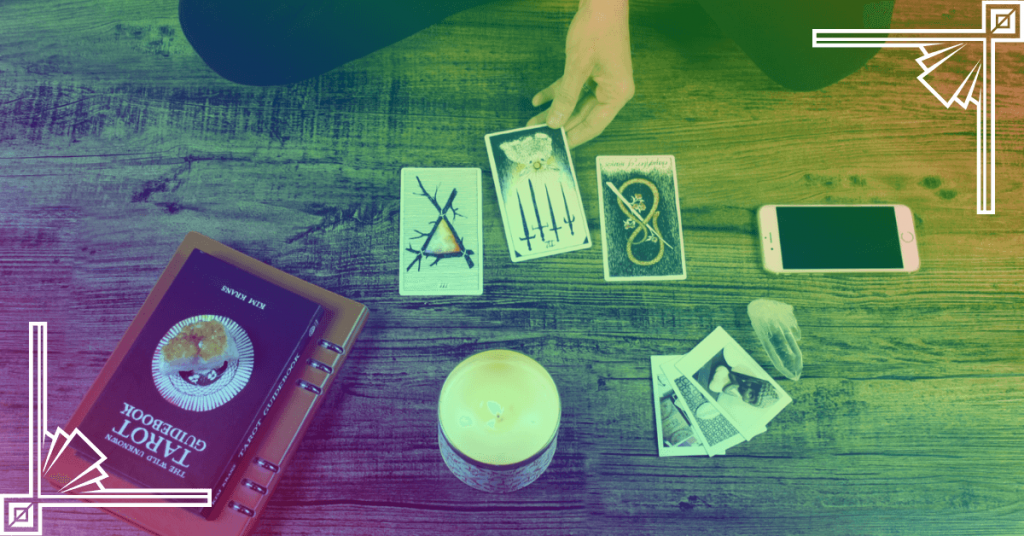As an Amazon Associate I earn from qualifying purchases.
At this point, there have been more tarot decks created than one person could try in a lifetime! And while it’s nice to have options to an extent, the wide range of tarot decks can make choosing one a stressful decision–especially if you’re a beginner.
If you find yourself paralyzed by all the tarot options out there, you’ve come to the right place! In this article, we’re going to take a look at some tried-and-true best tarot decks for beginners, as well as some general tips when choosing a deck for those with little experience.
There’s a great tarot deck out there for you, and I’m excited to help you find it! Let’s begin.

What Makes a Good Beginner’s Tarot Deck?
Before we take a look at any specific decks, I want to run through the general qualities that make a tarot deck well-suited for beginners.
Basically, there are two things to look out for in the purchasing process:
- Is the deck based on the classic tarot structure?
- Does the deck use vivid artwork and symbolism?

The Classic Tarot Format
While tarot decks may vary widely in their artwork and themes, many decks conform to the standard tarot format. And when you’re a beginner, this classic format is a must for building your tarot skills.
By working with the classic format early on in your tarot experience, you’ll find that the skills you develop will be easily transferable if and when you decide to branch out and experiment with new decks.
The best tarot decks for beginners are those that improve your tarot skills in general, not just your skills related to a specific deck.
What is the Classic Tarot Format?
When I speak about the “format” of a tarot deck, I’m referring to things like the total number of cards in the deck and how these cards are divided into groups. Below, we’re going to take a look at how this plays out in a traditional deck.
Total Number of Cards
Most tarot decks you encounter will have a total of 78 cards–making them a bit larger than a standard deck of playing cards. Some special decks have fewer or more cards than this, but if you find a tarot deck with 78 cards, there’s a good chance that it adheres to the classic tarot format.
How the Cards Are Divided
The 78 cards of a classic tarot deck are traditionally broken down into two groups–the minor arcana and the major arcana.
The minor arcana makes up the bulk of a tarot deck. It contains four suits of 14 cards each. Each suit has cards numbered 1 through 10, as well as four face cards. Traditionally, these suits are pentacles, cups, swords, and wands, while the face cards for each suit are the page, knight, queen, and king.

You may encounter a tarot deck that uses different suit names or face card names, but, even for beginners, this is generally okay. While the names used may be different, as long as the underlying structure of four suits/four face cards per suit is there, you should be fine.
The major arcana takes up the remaining 22 cards left in the tarot deck. When playing card games with a tarot deck, the major arcana cards are considered trump cards, and when using a deck for a reading, the major arcana cards are generally considered more significant than the minor arcana.

The major arcana features cards that are highly archetypical in their artwork and descriptive in their names. As with decks that don’t use the four traditional suit names, you may encounter decks that don’t use traditional names for the major arcana cards. Once again, this is fine as long as the underlying structure of 22 major arcana cards is there.
Vivid and Descriptive Artwork
Believe it or not, the artwork that a tarot deck uses is also important when choosing a beginning deck. Specifically, you’re going to want a deck that gives you plenty of concrete, visual imagery to work with.
Some decks use more abstract, esoteric artwork, and while there’s absolutely nothing wrong with that, I’ve found that beginners do best when they’re working with a deck that uses plenty of recognizable visual imagery. Especially when you’re just starting out, the images on cards will play a big role in helping your understand what meanings the cards hold.
There’s no hard and fast rules to what constitutes “plenty of concrete, visual imagery”, but here are a few simple tips to help point you in the right direction:
- Look for decks that use humans in the artwork. Not all decks do this, but it can be incredibly beneficial to see the energies and meanings of a card translated into a human experience.
- Look for a deck that naturally catches your eye, even if you can’t pinpoint what makes it so interesting to you. Everyone responds to different kinds of imagery, and it’s definitely a win if you can find a deck with artwork that just clicks with you and that you’re excited to explore.
- Symbolism is a must, but avoid decks that beat you over the head with interpretations. Some tarot artwork styles can be too on the nose–you don’t want a deck that does all the interpreting for you. Tarot is a synthesis of collective symbolism and personal intuition. If your deck doesn’t allow you to leap into the mysterious and not-at-all-clear-cut world of interpretation, your intuitive skills will suffer.
How Do I Choose the Right Deck for Me?
We’ve gone over some general advice for choosing a deck, but how do you translate that into your own personal experience? Below, we’re going to look at a few tips to help you make a deck choice that works for you specifically.
Tip #1: Don’t Aim for Perfection
Unfortunately, there are no “perfect” tarot decks in the world–only those that are better or worse than others in specific contexts.
When you’re looking for your first deck, it’s super important not to get bogged down in the quest for perfect, because spoiler alert: it ain’t happening. You want to make a thoughtful decision, for sure, so don’t rush in without any research, but if you find yourself paralyzed by the seemingly infinite choices out there, just remember this–ANY tarot deck is better than NO tarot deck.
Tip #2: Go With Your Gut
Like I said earlier, a big part of tarot is your own personal intuition, so don’t be afraid to apply that intuition to buying a deck as well. A deck that you feel strongly about or have a personal connection to is absolutely going to work better in your hands than one that doesn’t inspire you.
When you’re browsing tarot decks take note of those that jump out at you–that’s a sign that you’re on the right track to choosing a good one.
Tip #3: Don’t Rush the Process
There’s no specific timetable when it comes to finding the right tarot deck for beginners. Even if you find a deck that sparks your interest a little, there’s no guarantee that it will be love at first sight, which is absolutely fine.
It can take several readings to really get a feel for the rhythms and energies of a specific deck, so don’t toss it just because the first use didn’t go as perfectly as you expected. If you’ve been using a deck for months and it feels like pulling teeth every time, sure, that might not be the right deck for you. But a little awkwardness and complication is to be expected while you’re first learning to use a new deck.
The Best Tarot Decks for Beginners
Now it’s time to take a look at specific decks! Each of these presents unique symbolism and imagery, but they all adhere to the same underlying format, making them perfect for tarot newbies.
The Rider-Waite Tarot
When people imagine tarot cards, there’s a good chance that they’re thinking of the classic Rider-Waite deck. This deck is over 100 years old at this point, and it’s probably the most iconic example of the standard tarot format.
I try to avoid one-size-fits-all recommendations, but if there’s one deck I would recommend to all beginners without qualification, it’s the Rider-Waite Tarot.
I think that the imagery in this deck is some of the best that’s ever been developed for tarot. The images are at the same time simple, yet highly mysterious and symbolic. The artwork is easy to grasp on a surface level, but its symbolism runs deep, which requires thought and effort on the part of the reader to gain insight.
Making the Rider-Waite Tarot your first deck is a smart move, because so many of the tarot decks developed after it are based directly on its format and themes. If you can master the Rider-Waite deck, it will open all sorts of doors in the world of tarot.
Learn More About the Rider-Waite Tarot
The Wildwood Tarot
If you’re a nature lover, the Wildwood Tarot might be the perfect choice for you. This deck is based on the Rider-Waite deck, but it has a much more pagan-y, Celtic vibe. It’s a great choice for tarot beginners with a Wiccan background–you’ll likely recognize some of the symbols and figures used in the deck’s artwork.
While the Wildwood Tarot does conform to the classic tarot format, it’s also arranged based on the pagan Wheel of the Year and the four traditional elements. The cards all correspond to specific times of year, holidays, and elemental influences, giving you an interpretive framework that you won’t find with the classic Rider-Waite deck.
In addition to containing highly symbolic images, the cards feature some of the most technically stunning artwork I’ve ever seen used for a tarot deck. Even if this deck isn’t your cup of tea, if you’re an art lover, I highly recommend browsing through these cards.
Learn More About The Wildwood Tarot
The Modern Witch Tarot
If you’re already familiar with the Rider-Waite Tarot, The Modern Witch Tarot should look mighty familiar to you–it’s basically the classic deck with updated artwork for a new generation of tarot fans.
The artwork, fantastically done by American artist Lisa Sterle, retains much of the old symbolism of the original deck while incorporating an all-female cast of characters and a few modern, pop culture twists thrown in for good measure.
Many of the things that make the Rider-Waite deck a good choice for beginners apply to the Modern Witch deck as well. However, I would recommend this deck specifically for beginners who may be struggling to make a connection with the artwork and symbolism of the classic deck.
This is definitely a deck of the 21st century in terms of what it’s presenting, and that could be just what you need to help deepen your relationship with tarot.
Learn More About The Modern Witch Tarot
The Mythic Tarot
The Mythic Tarot was originally released in 1984, and it very well may be the best tarot deck variation we’ve had in decades. In a nutshell, these beautifully illustrated and highly symbolic cards combine elements of the classic Rider-Waite with Jungian archetypes and Greek mythology.
While tarot decks can be used to ask all sorts of questions or explore all sorts of situations, some decks are better suited for certain tasks than others. In the case of the Mythic Tarot, it’s the perfect deck for individuals who want to perform readings for themselves or who want to explore issues of the “inner world”–like emotions, psychology, and the subconscious.
Additionally, the instruction book that comes with the deck is particularly thorough and illuminating. Up until this point I haven’t really talked about instructions booklets because they’re much less important than the deck itself–the instructions that come with a deck aren’t binding or definitive, and many times they just downright stink.
However, if you ask any fan of the Mythic Tarot what they like about it, the accompanying book will inevitably come up in conversation. It’s high quality enough to warrant a mention.
Learn More About The Mythic Tarot
Revelations Tarot
The final deck I want to look at today is the Revelations Tarot. Like the others on this list, Revelations is based on the classic Rider-Waite format but with one major twist–this deck incorporates reversed card meanings into the artwork.
For those that are unfamiliar, when a tarot card is flipped and the artwork is upside down, we call that card “reversed.” Some tarot readers don’t incorporate the orientation of the cards into their readings, but for those that do, reversed cards generally represent the opposite of what they mean when upright.
The Revelations deck has beautifully and symmetrically incorporated those reversed meanings into the artwork for each and every card. Additionally, like the Mythic Tarot, this deck is particularly good for beginners who want to explore themes of self-discovery and self-improvement.
Learn More About Revelations Tarot
Find the Tarot Deck That’s Right For You
I hope that this article has been illuminating, and hopefully you’ve got a few ideas for finding the right tarot deck for you. Just remember–tarot is a process, not a one-time thing. Don’t be afraid to experiment with multiple decks, and don’t worry if your first choice doesn’t click with you instantly.
With a little curiosity and boldness, you’re sure to find something that works for you.
If you’d like to have more tarot in your life, be sure to sign up for the Explore Wicca Monthly Tarot newsletter. Each month on the 1st, you’ll receive a free tarot reading that investigates the dominant energies for the coming month and how to bring your best self to the days ahead.
Thank you for reading, and I hope that what you’ve seen here today will help progress you on your own unique spiritual journey.
Until next time,
Didi





